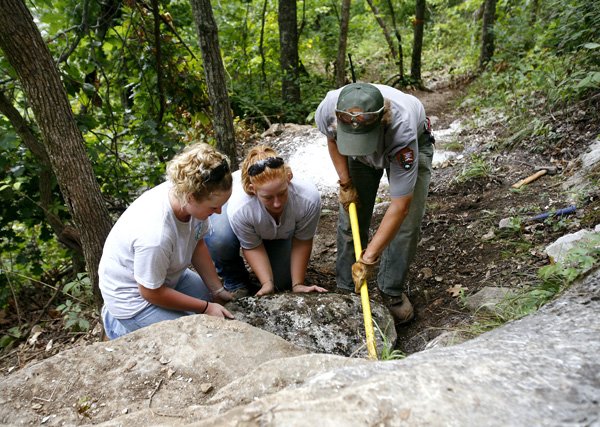NORTHWEST ARKANSAS — Being airlifted from a gravel bar on the Buffalo National River after suffering heatstroke wasn’t a life-changing experience for Jorden Campbell. Rather, it was her job with the Youth Conservation Corps itself that has influenced the path Campbell believes her future will take.
“Ever since I got this job, I planned on going to college to come back and work here,” Campbell said while taking abreak from clearing rock and debris from the Hemmed-In Hollow trail at the Buffalo National River.
“I just like being out here teaching people what nature is all about,” she said.
Campbell, 16, of Harrison is one of about 40 students who have been working for the Youth Conservation Corps at the national river for an eight-week period that ends Friday. She is among about 30 in the group who spent their time bringing the steep 2.
5-mile Hemmed-In Hollow trail back to U.S. National Park Service standards.
The only mishaps over the summer were minor cuts and bruises until last week, said Rachel Green Norton, a fire management assistant and team leader. On July 21, Campbell and another worker, Hadassah Raver, 15, succumbed to the heat and had to be evacuated from the trail. Norton said that all but seven of the workers were sent back up the Hemmed-In Hollow trail, while the rest movedthe two girls to the river for transport.
A medical helicopter from Springdale landed on a gravel bar at Horseshoe Bend, according to a news release by Caven Clark, park spokesman.
From there, Campbell was flown to Washington Regional Medical Center in Fayetteville, while Raver was taken by canoe to Kyle’s Landing. Raver was not taken to a hospital.
The day after the evacua-tion, the workers were kept inside for a debriefing and asked whether they wanted to return to the trail, said Kevin Cheri, park superintendent.
“They all said ‘Yes,’” Cheri said.
Cheri, who toured the work area Tuesday, said instilling a strong work ethic is one of the corps principles. He said that for the rural area near the river, it is one of the few summer jobs available.
Much of the money paying for the $126,500 program - $89,500 - comes from the American Recovery and Reinvestment Act, said Mark Foster, chief of facility management for the park. About 90 percent of the program’s cost goes to wages for the young workers.
The workers come from all over the area, from as far south as Deer to near the Missouri border at Lead Hill, Cheri said. They earn $7.25 an hour. They can also gain a greater attachment to the country’s first national river.
“National parks are America’s best idea,” he said.
The stimulus money allowed the park to increase the number of students it hired, both this year and last year, Cheri said. Prior to that, the park was able to bring in only 6-10 students.
This year, there were 90 applicants for the program, Cheri said. The jobs are so sought-after that when workers had to quit, the next person on the list was ready to step in, even with just threeweeks left in the program, he said.
Looming budget cuts may mean next year’s program will be greatly reduced, but if the money is there, Fostersaid he can easily find work for dozens of workers.
Park service standards call for a 4-foot by 8-foot area around trails to be clear of brush, which was one of the workers’ tasks this summer, said Lane Deming, a maintenance worker and team leader.
The trail should be 3 feet wide and as smooth as possible, which requires removing roots and rocks, Deming said. In patches where runoff turns the trail to mud, teams build rock walls and spread large gravel, he said.
Because no materials are brought in, gravel must be made by breaking up large rocks, which seems to be a favorite task of the workers, Deming said. The gravel is also used as a base for rock steps that are installed on some of the steepest portionsof the Hemmed-In Hollow trail.
Park service literature describes the Hemmed-In Hollow trail as “very strenuous,” as there is an 1,100-foot elevation change. The five-mile round trip is expected to take five hours from the Compton trailhead to Hemmed-In Hollow, the tallest waterfall between the Rocky and Appalachian mountains.
Corps workers have spent four days a week on the trail, with Mondays reserved for environmental education, Norton said. The training sessions range from lectures on park resources to float trips to clean the river, she said.
By week’s end, the workers plan to finish restoring the Hemmed-In Hollow trail to the 204-foot waterfall. If time remains, they maytackle a fork that leads to the river, said Don McNeil, another team leader.
McNeil said by this far into the program the workers are free to choose what area of the trail they want to work on. A group of nine volunteered to work at the bottom of the hill, he said.
McNeil’s team got on the trail about 9 a.m. Tuesday and by about 1 p.m. had finished work, hidden their tools and started the trek back up the hill. They planned to return to continue the work today.
Albert Earl Munyon, 16, of Harrison reflected on the experience as he dug a rock out of his shoe.
“It’s a good walk down, not up,” Munyon said. “It’s more of a trail for [hiking in the] fall.” To contact this reporter:
Northwest Arkansas, Pages 7 on 07/29/2010

